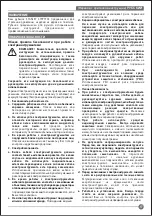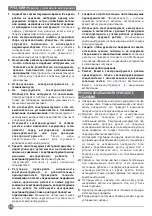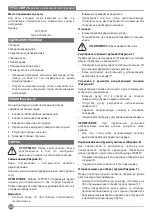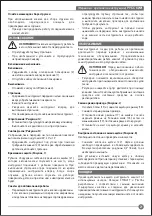
ENGLISH
(Original instructions)
8
• Turn the knob to the ‘P' postion whenever the tool is not in
use.
Fitting and removing the parallel fence (Fig. D)
The parallel fence is used to for optimum control on narrow
workpieces.
• Thread the knob (11) into the hole on the side of the
planer and securely tighten.
• Loosen the parallel fence adjustment knob (10).
• Slide the parallel fence into the desired position.
• Securely tighten the parallel fence adjustment knob.
NOTE:
The parallel fence should be below the planer when
installed correctly.
• To remove the parallel fence proceed in reverse order.
Connecting a vacuum cleaner to the tool (Fig. E)
An adaptor is required to connect a vacuum cleaner or dust
extractor to the tool. The adaptor can be purchased from your
local STANLEY retailer.
• Slide the adaptor (12) over the shavings discharge
outlet (3).
• Connect the vacuum cleaner hose (13) to the adaptor.
Fitting the shavings collection bag (Fig. F)
The shavings collection bag is particularly useful when
working in confined spaces.
• Slide the connecting plate (14) of the bag over either side
of the shavings discharge outlet (3).
• To prevent chips from coming out opposite side of
shavings discharge outlet, move the shavings discharge
outlet selector (4) to the opposite side from the bag.
Emptying the shavings collection bag
The shavings collection bag should be emptied regularly while
using it to prevent blocking.
• Unzip the bag and empty it before continuing.
USE
WARNING!
Let the tool work at its own pace. Do
not overload.
• Adjust the depth of cut.
• If necessary, fit and adjust the parallel fence.
Switching on and off
Switching on
• Keep the lock-off button (2) depressed and press the
on/off switch (1).
• Release the lock-off button.
Switching off
• Release the on/off switch.
Planing
• Hold the tool with the nose piece of the shoe resting on
top of the workpiece surface.
• Switch the tool on.
• Move the tool steadily forward to perform the cutting
stroke.
• Switch the tool off after the stroke has been completed.
Rebating (
Fig.
G)
• Fit and adjust the parallel fence.
• Proceed as for planing.
Chamfering edges (
Fig.
H)
The V-groove in the nose piece of the shoe enables you to
chamfer edges at 45°, 30° and 15° angles.
• Hold the tool at an angle with the desired groove (20)
around the edge of the workpiece and perform the cutting
stroke.
Parking rest (
Fig.
I)
Your planer is equipped with a parking rest (21) that
automatically lowers into place when the tool is lifted from the
work surface. When planing, the parking foot raises as the tool
is pushed forward. When the parking foot is lowered, the
planer can set on the work surface without the blade touching.
Hints for optimum use
• Move the tool along the grain of the wood.
• If the grain is cross or curly, or if the workpiece material is
a hard type of wood, adjust the depth of cut to take only a
very thin shaving at each pass and take several passes to
achieve the desired result.
• To keep the tool in a straight line, press down the front of
the tool at the start, and press down the back of the tool at
the end of the cutting stroke.
MAINTENANCE
Your tool has been designed to operate over a long period of
time with a minimum of maintenance. Continuous satisfactory
operation depends upon proper tool care and regular
cleaning.
WARNING!
Before performing any maintenance,
switch off and unplug the tool.
• Regularly clean the ventilation slots in your tool using a
soft brush or dry cloth.
• Regularly clean the motor housing using a damp cloth. Do
not use any abrasive or solvent-based cleaner.
Replacing the drive belt (
Fig.
J)
• Loosen the screws (15) and remove the cover (16).
• Remove the old drive belt.
• Place the new belt (17) over the pulleys. Place the belt
over the large pulley (18) first, then over the small pulley
(19), whilst manually rotating the belt steadily.
• Put the cover back in place and tighten the screws.
Motor brush inspection and replacement
(
Fig.
K)
Brushes should be regularly inspected for wear.
• Remove brush cap (22). The brushes should slide freely in
brush box. If brushes are worn down to 0.3" (8mm) they
should be replaced.
To reinstall, push new brush back into brush box. If replacing
existing brush, maintain same orientation as when removed.
Replace the brush cap (do not overtighten).
Содержание STPP7502
Страница 1: ...STPP7502 English Page 05 French Page 11 Russian Page 17 Ukrainian Page 24 Turkish Page 30 Page 21...
Страница 2: ...2 1 3 4 5 6 ENGLISH Original instructions 2 A...
Страница 3: ...9 5 6 10 11 4 3 14 3 12 13 7 8 Original instructions ENGLISH 3 B C D E F G...
Страница 4: ...N P 19 17 21 20 16 18 15 22 ENGLISH Original instructions 4 H J I K...
Страница 17: ...17 STANLEY STPP7502 1 a b c 2 a b c d e f 3 a b c d e...
Страница 18: ...f g h 4 a b c d e f g h 5 a b d e f g 18...
Страница 20: ...2017 XX JN 1 2 1 1 1 1 1 A 1 on off 2 3 4 5 6 B STPP7502 7 8 C 9 6 5 P D 11 10 E STANLEY 12 3 13 F 14 3 4 20...
Страница 21: ...21 2 1 on o G H V 45 30 15 20 I 21 J 15 16 17 18 19 K 22 0 3 8 STANLEY Piranha...
Страница 24: ...STPP7502 STANLEY 1 a b c 2 a b c d e f 3 a b c d e f 24...
Страница 25: ...25 g h 4 a b c d e f g h 5 a a b c d e f g h i...
Страница 27: ...27 1 2 TCT 1 1 1 1 1 C 1 2 3 4 5 6 B STPP7502 7 8 C 9 6 5 P D 11 10 E STANLEY 12 3 2017 XX JN A n0 II 0...
Страница 28: ...13 F 14 3 4 2 1 G H V 45 30 15 20 I 21 J 15 16 17 18 19 K 22 0 3 8 28...
Страница 38: ...H dG F dG dG 38 5 P D 11 10 E 3 12 13 F 14 3 2 1 G H V 15 30 45 20 I 21 J 16 15 17 19 18...
Страница 40: ...H dG F dG dG 40 d e f g h i j STANLEY STANLEY 1 5 0 75 1 00 1 50 2 50 4 00 6 10 15 20 25 2...
Страница 42: ......























